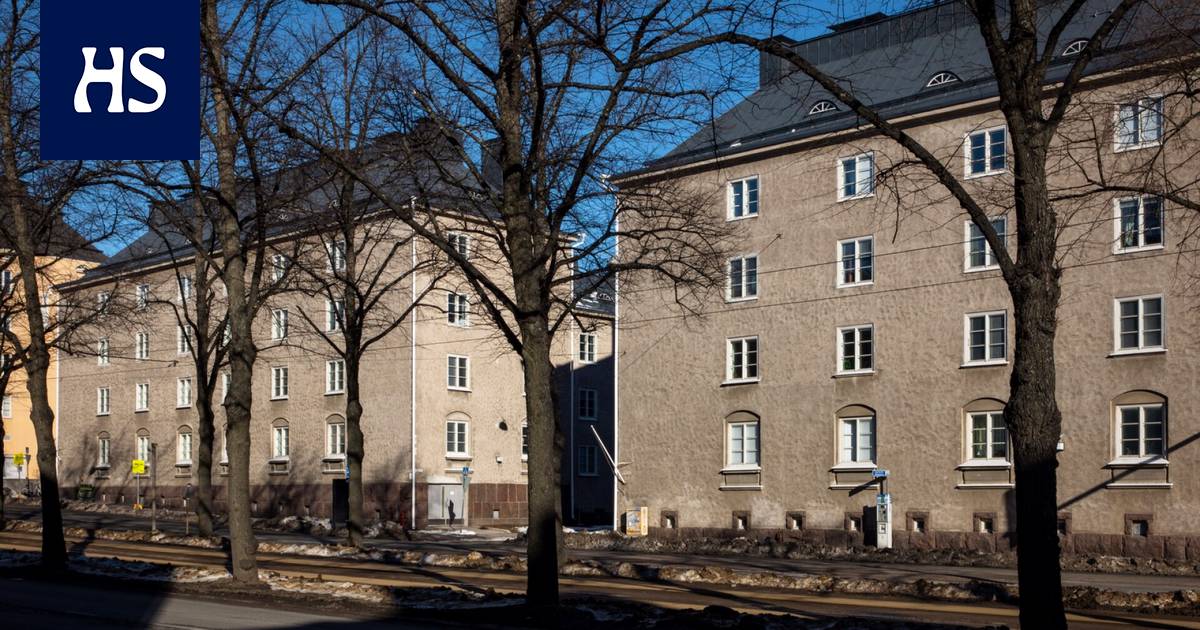The old ones In the eaves of apartment buildings, there are sometimes basements that are behind their time. Outdated square meters are perhaps downright wasted space, as was the case in Vallila Pienasunnot no. 2 at Mäkelänkatu 23–25 in Helsinki.
A few years ago, in connection with the plumbing renovation, the basements in the housing company were also converted into modern utility rooms for active and productive use.
Architect Uno Mobergin designed house was completed in the mid-1920s as workers’ apartments. The apartments are indeed small, which emphasizes the importance of common spaces. The housing association comprises two buildings.
When you get to know the renovated premises on site, you can see that the spirit of the old house is still there in the labyrinthine corridors, even though the walls have been torn down and new ones built.
The house’s shapes catch the eye even from the outside, viewed from the courtyard.
From the courtyard side, the apartment complex is elegant. The curved shape of the outer surface of the stairwell is especially pleasing to the eye.
“Before the renovation, the basement premises were in their original condition, and according to the articles of association there were wood and food cellars, three laundry rooms and two mantel rooms,” says the property manager Mikko Kultaranta.
They stored stuff that could withstand humid conditions.
So the food cellars were cool potato cellars. It used to be used to store potatoes in them in autumn for the winter.
Property manager Mikko Kultaranta says that the money invested by the building company in the renovation of the work premises will be returned as rental income.
Under renovation among other things, five work rooms for rent were created, from which the housing association receives more than 30,000 euros in rental income each year. Kultaranta says that it is difficult to separate the costs of the basement renovation from the housing company’s entire repair costs, which were six million euros.
Kultaranta says that in general, in this kind of renovation, it is important to plan everything well and take care of good supervision and project management. “Furthermore, it is really important to find out which are the long-term sustainable and financially sensible choices.”
The building Three siblings are now working in the workspace next to the wall on Mäkelänkatu, each with their own company. We enter the room through a low door, crouching a little.
Teija Lenjas presents a low hobbit or elf door through which you can go to the sewing room.
“Customers have called it a hobbit door and an elf door. One said he came to see what kind of door it was,” he says Teija Lenjas. She runs her own sewing business on the premises, as do her two sisters.
Lenjas Teperiitus company’s type is clothing sewing, Marjo Savolainen The field of personal design is interior sewing, and for the third sister, who is not present, Onezille focuses on repairs and latex clothing.
The space is partly underground, so the sound of the busy traffic that rushes down Mäkelänkatu can only be heard with a sensitive ear. The walls of the building are also thick, and soundproof windows were installed during the renovation.
The sewing shop has been operating in the workspace since the renovation of the house was completed in 2018. The sisters say that the space is very suitable for sewing.
The hobbit door also leads to another workspace. The resident of the house is busy there Jiri Salin. “The commute is short as I live upstairs. I get to work indoors. There is nothing wrong with this workspace; during the corona, this was salvation.”
The housing association consists of two separate buildings. Bike cellars were also built in place of the long garage in both.
Maija Bergström, a partner in the housing company, presents the renovated basement spaces.
Housing company a partner who was on the board during the renovation Maija Bergström says that many cyclists live in the house, less motorists. The garages of the old house were cramped and awkwardly shaped for modern cars. “It was difficult to find tenants. The garage was rented to an outside company that had cars. However, the rental income from large premises was low,” says Bergström.
Elongated garages cramped for cars were converted into bike cellars.
The wheels are attached to racks that keep them straight. Thanks to the racks, the order remains good.
The bicycle space has several eye-catching details, such as mailboxes in the work spaces and Posti’s Smartpost parcel machine, where you can order packages.
There is a place in the basement for washing the wheels.
The picture during the renovation shows that a new floor was made in the basement and the surfaces of the walls were also renewed.
There is also a washing station for bicycles, a stroller parking lot in the corner for prams, and a shelf for recyclables. There is also a notice board on the premises.
The bike cellar also has mailboxes for work spaces and Posti’s Smartpost parcel machine, where you can order packages.
Prams can be left in the pram park in the side part of the bicycle space.
The bike compartment pump is attached to its branches with a chain.
There is also a shelf for recyclables in the basement.
We walk in a labyrinthine corridor. Bergström says that the house used to be heated with coal, and during the renovation, for example, the coal drop hatch was closed. Originally, the apartments had tiled stoves for heating.
A few tile kilns are still in working order.
Today, of course, the house has district heating.
Bergström seems very satisfied with the results of the renovation. “Today, the common spaces are a selling and renting asset in the house. They are always brought up in sales announcements as factors that increase living comfort.”
On the wall of the corridor, a framed old Uu Suomen article about the construction of the House of Parliament draws attention: Pictures of the future House of Parliament. The article gives a glimpse of what the old house is like. It was completed before the House of Parliament.
Kultaranta says that the article was found under the floor of one of the premises during the moisture repair.
In the maze-like corridor, there is a framed old newspaper article that told about the future House of Parliament. The magazine was found under the floor during damp repair.
We enter the living room of the house, which can be reserved for a variety of uses. Behind one door is the Birger Gym, which can be used free of charge.
Both buildings also have free washrooms with drying rooms. Of course, the costs are covered in the fees.
Residents can use the washrooms free of charge.
Great sauna facilities are also welcome. Before the renovation, there were none in the housing association. The sauna is booked through the mobile app, just like other common spaces.
Before the renovation, the sauna facilities had a partly underground basement that was practically wasted space.
Before the renovation, the sauna facilities had a partially underground basement that was practically a waste space.
The gym has a selection of different weights.
There is also a quiet sitting room hidden in the attic of the house.
Modern cage warehouses were made into the old basement, which was partly earth-based and intended for storing wood and potatoes.
Specially There is a lot of old building stock in Helsinki. Over the decades, basements lag behind the demands of the times. “If nothing has been done for, say, 60 years, some kind of update is definitely ahead. It’s often worth doing an update in connection with some other major renovation,” says Isännöintliitto’s leading legal expert Jenni Valkama.
“If you want to make significant changes to the purpose of use in a housing association, you should ask experts for technical and legal advice.”
The articles of association may stipulate that every apartment has a cold cellar. If you want to change them to another use, the articles of association must be changed, which again requires the approval of the shareholders.
Valkama says that when renovating the common basement spaces of the housing association, the pursuit of ecology and the idea of shared use are becoming more common. “It seems that communal saunas, for example, are on the rise.”
As in Vallila’s Pienasunnot no. 2, also in many other old housing estates, the old-fashioned small garages have been converted into bike storage.
Valkama considers the solution of the housing company in Vallila to make workspaces that can be rented out to outsiders good, as it brings income to the company. Of course, the solution requires that the shareholders want it.
“If the premises are not suitable for renting to outsiders, it could nevertheless be a good idea to change them in such a way that they are more suitable for use by residents, even as remote work spaces.”
of the Circular Green Blocks project with the project manager Lassi at Sarlos there are tips for building societies renovating their old basements. The project promotes the sharing and circular economy with housing associations and companies.
It can be good to think about what types of shared use can be used in a housing association. The development of digital technology offers an opportunity for, for example, object lending companies. You register at the loan company with strong identification and pay for loans digitally.
Good rental items include tools, cleaning equipment, yard games and textile washers. Likewise, an electric cargo bike.
Sarlos urges building societies to map the wishes of shareholders and residents about what they want. In this way, the future facilities can meet the needs better.
A shared electric car may also be a good idea to consider, especially in Helsinki, where parking is more expensive and parking spaces are scarce in a city that is becoming more compact.
#Housing #Helsinkibased #housing #company #tens #thousands #euros #year #basement #premises







